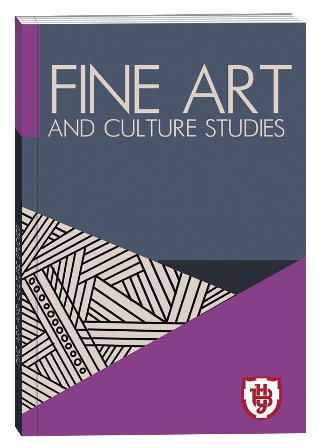MUSICAL ENVIRONMENT: PECULIARITIES AND PROBLEMS OF INVESTIGATION
DOI:
https://doi.org/10.32782/facs-2022-2-3Keywords:
musical environment, musical activity, investigation, method.Abstract
The article focuses on musical environment as an integral phenomenon, possible vectors and specifications of its investigation are determined. It is found out that musical environment covers all the components of the processes of sound music product creation, spreading and perception of this product, it is based on music activity. Formation of musical environment is conditioned by time-space factors and dynamics of social changes. At the macro-level musical environment is entire musical sound atmosphere of the Earth, at the micro-level it is a direct surrounding of the individual “here and now”. Performers influence musical environment directly. Peculiar “co-authors” in creation of actual musical environment are also listeners who not directly influence composing and performance activity by means of their preference. Environment is always regarded relative to the system which it surrounds (society of a certain historical period, the territory – town, region, country, educational institution, concert establishment, personality). It is emphasized that understanding of ways of functioning and regularities of musical environment organization as a heterogeneal, multipleaspect phenomenon presupposes interdisciplinary approach and can be carried out by means of a complex of general and specific methods of investigation, in particular, sociological, psychological, historical, culturological, specific musicological. While investigating musical environment, it is suggested to base on the theory of “social fact”, “common field”, to use such methods as: historical systemic, historical comparative, observation, polling (questionnaire), regional analysis and specific methods of musicological investigation – musical theoretical and performance analysis as well.
References
Адорно Т. Эстетическая теория. Москва : Республика, 2001. 527 с.
Арановский М. Г. Музыка и мышление. Музыка как форма интеллектуальной деятельности. Москва : Книжный дом «Либроком», 2009. С. 10–43.
Асафьев Б. В. Книга о Стравинском. Ленинград : Музыка, 1977. 279 с.
Басова А. Г. Концепт музики в соціологічній теорії ХХ століття. Наукові записки НаУКМА, 2015. Т. 174. С. 40–45.
Бацак К. Ю. Музично-комунікативне середовище італійської опери в Одесі (досвід театрального сезону 1852–1853 років). Часопис Національної музичної академії України імені П. І. Чайковського, 2018. № 2 (39). С. 67–86.
Бонь О. І. Музичне середовище Києва 1920 років у дзеркалі его-документів. Українська історична наука в сучасному освітньому та інформаційному просторі. Вінниця : ТОВ «ТВОРИ», 2018. С. 338–349.
Гибсон Дж. Экологический подход к зрительному восприятию. Москва : Прогресс, 1988. 464 с.
Дворський Г. І., Чепіга С. Г. Вплив освітньо-музичного середовища на розвиток особистості школяра. 1025-річчя історії освіти в Україні: традиції, сучасність та перспективи. Київ, 2014. С. 93–101.
Дюркгейм Э. Социология. Ее предмет, метод, предназначение. Москва : Канон, 1995. 352 с.
Кавунник О. А. Музичне середовище, як обʼєкт музичного краєзнавства. Українське музикознавство, 2018. Вип. 44. С. 98–106. 11. Карпова Т. Н. Женская драма: театральная среда как стимул творчества. Исторические, философские, политические и юридические науки, культурология и искусствоведение. Вопросы теории и практики. Тамбов : Грамота, 2013. № 5. Ч. 2. С. 76–79. 12. Кордуэлл М. Среда. Кордуэлл М. Психология. А–Я. Словарь-справочник. Москва : Фаир-Пресс, 2000. 448 с.
Кремер Г. Обертоны. Москва : АГРАФ, 2001. 352 с.
Линтон Р. Личность, культура, общество. Вопросы социальной теории . 2007. Том 1. Вып. 1. С. 175–190.
Лісовська Т. А. Вплив музичного середовища на розвиток імпровізації в дітей дошкільного віку. Науковий вісник Миколаївського нац. ун-ту імені В. О. Сухомлинського, 2014. Вип. 1.45 (106). С. 83–86.
Мартинів Л. І Музично-мистецьке середовище та педагогічна традиція Дрогобича як передумови професійної самореалізації Богдана Сюти. <http://new.ddmu.org.ua> (2022, квітень, 15).
Мельникас Л. Экология музыкальной культуры Москва : Композитор, 2000. 328 с.
Мусіяченко О. С. Історичні події як фактор впливу на розвій музичного середовища Києва другої половини ХІХ – початку ХХ ст. Київські історичні студії, 2017. № 2 (5). С. 71–77.
Сбітнєва Л. М. Розвиток системи музично-естетичного виховання дітей і молоді в Україні (друга половина ХХ століття) : дис. ... д-ра пед. наук: 13.00.01. Київ, 2016. 406 с.
Середовище. Академічний тлумачний словник української мови: в 11 томах, 1978. Т. 9. С. 137.
Фуртвенглер В. Из литературного наследия. Исполнительское искусство зарубежных стран. Москва : Музыка, 1966. Вып. 2. С. 146–187.
Хейдметс М. Субъект, среда и границы между ними. Психология и архитектура : тезисы конференции в Лохусалу (20–22 января 1983, Таллин). С. 124–137.
Хьелл Л., Зиглер Д. Альфред Адлер: индивидуальная теория личности. Теории личности основные положения, исследования и применение. Санкт-Петербург : Питер, 2008. 607 с.
Brand M. Relationship between home musical environment and selected musical attributes of second-grade children. JRME, 1986. Vol. 34. № 2. Р. 111–120.
Dell C., Rinnert N., Yap C., Keith T., Zdzinski S., Gumm А., Orzolek D., Cooper S., Russell B. Musical home environment, family background, and parenting style on success in school music and in school. Contributions to Music Education, 2014. Vol. 40. Р. 71–89.
Mallett A. An examination of parent /caregiver attitudes toward music instruction, the nature of the home musical environment, and their relationship to the developmental music aptitude of preschool children : a dissertation of doctor of philosophy. The University of Nebraska-Lincoln, 2000. 167 р.
Markusen A. Region: The Economics and Politics of Territory. New Jersey : Rowman & Littlefield, 1987. 304 р.
The impact of the home musical environment on infants’ language development. Infant Behavior and Development, 2021. Vol. 65. <https://www.sciencedirect.com/journal/infant-behavior-and-development/vol/65/suppl/C>. (2022, April, 8).







